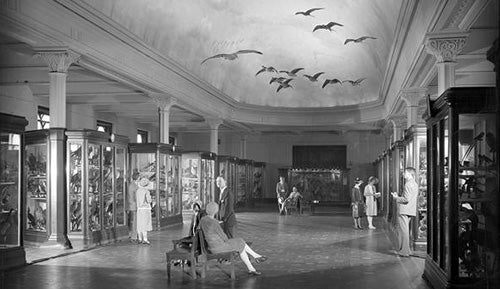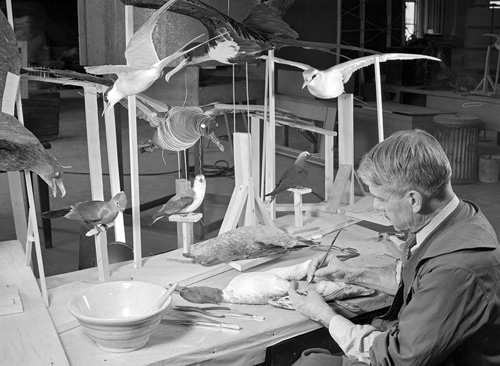The Museum of Natural History in The Catcher in the Rye

Visitors viewing display cases and Bird Dome, Hall of the Birds of the World, 1927, American Museum of Natural History, Photographer: H. S. Rice. Image and original data provided by Library, American Museum of Natural History
Visiting the Museum of Natural History was high on my list of priorities on my first trip to New York City. This was in big part due to its mention in J.D. Salinger’s The Catcher in the Rye—even if, to be honest, I didn’t quite remember the role it played in the book.
Like Holden Caulfield, the novel’s young protagonist, I was deeply fascinated by the dioramas of people and animals in their environments. A few years later I moved to New York, and while I always enjoy strolling through the museum’s fossil halls, the Butterfly Conservatory, and the temporary exhibits, the dioramas still remain my favorite.
Of course I was excited when Artstor reached an agreement with the museum to release 1,500 images, nearly 900 of them documenting those dioramas (including their creation and maintenance). Poring over the black and white photographs inspired me to revisit The Catcher in the Rye.

Raymond B. Potter prepares birds for mounting, 1939, American Museum of Natural History, Photographer: Charles H. Coles. Image and original data provided by Library, American Museum of Natural History
I had forgotten how melancholic the chapter actually is. As Holden Caulfield walks to the museum, he reminisces about his previous visits on class trips. Caulfield says that what he likes about the Museum of Natural History is how life is trapped in its exhibits: Eskimos fishing and birds flying are always frozen in the same positions, unchanged and unchangeable in contrast to the changes that he has experienced between visits.
Boy, that museum was full of glass cases. There were even more upstairs, with deer inside them drinking at water holes, and birds flying south for the winter. The birds nearest you were all stuffed and hung up on wires, and the ones in back were just painted on the wall, but they all looked like they were really flying south, and if you bent your head down and sort of looked at them upside down, they looked in an even bigger hurry to fly south. The best thing, though, in that museum was that everything always stayed right where it was. Nobody’d move. […] Nobody’d be different. The only thing that would be different would be you.
My biggest surprise was discovering that Caulfield doesn’t actually go into the museum. Disturbed by the possibility of having to face how he has changed since his last visit, he gets to its doors and says, “Then a funny thing happened. When I got to the museum, all of a sudden I wouldn’t have gone inside for a million bucks.”

Children viewing North West Coast Canoe, 77th Street Foyer, 1962, American Museum of Natural History, Photographer: Alex J. Rota. Image and original data provided by Library, American Museum of Natural History
Ironically, the Great Canoe, one of Holden’s favorite displays, has changed since the book was written. The figures on the boat are no longer there. But thanks to the collection in Artstor, you can see the image as Holden saw it; unchanged, just as he expected.
View Artstor’s American Museum of Natural History collection in JSTOR.